Renal Dosing Calculator for Metformin
Metformin Dosing Calculator
Enter your estimated glomerular filtration rate (eGFR) to determine the maximum daily dose of metformin that is safe for your kidney function.
This is your kidney function measurement. Typically measured by blood test.
Enter your eGFR value to see your maximum safe dose
When you have type 2 diabetes and chronic kidney disease, the medications you take need to change-not because they stop working, but because your kidneys can’t process them the same way. This isn’t just about avoiding side effects. It’s about keeping your heart and kidneys protected while still controlling your blood sugar. Two of the most important drugs in this space-metformin and SGLT2 inhibitors-have seen major shifts in how we dose them based on kidney function. The old rules are outdated. The new ones are backed by years of large clinical trials and are now the standard in guidelines from the American Diabetes Association and Kidney Disease: Improving Global Outcomes (KDIGO). But here’s the problem: many doctors still follow old labels, and insurance companies often deny prescriptions that follow the latest science.
What Changed in Renal Dosing for Metformin?
For years, metformin was banned if your eGFR dropped below 60 mL/min/1.73 m². That meant a lot of people with early kidney disease lost access to the most effective, safest, and cheapest diabetes drug available. But in 2016, the FDA updated its guidance after reviewing over 100 studies. The new truth? The risk of lactic acidosis from metformin is extremely rare-just 3.3 cases per 100,000 patient-years. That’s less likely than being struck by lightning.
Now, you can safely take metformin even with moderate kidney impairment. Here’s the current dosing map:
- eGFR ≥60 mL/min/1.73 m²: Max dose 2550 mg/day
- eGFR 45-59 mL/min/1.73 m²: Max dose 2000 mg/day
- eGFR 30-44 mL/min/1.73 m²: Max dose 1000 mg/day
- eGFR <30 mL/min/1.73 m²: Stop metformin
Some experts will still prescribe 500 mg daily in patients with eGFR 15-29 mL/min/1.73 m² if they’re stable and closely monitored-but this is off-label and not officially recommended. The key is to check your kidney function every 3 to 6 months if your eGFR is between 30 and 59. If it drops below 30, stop metformin. Don’t wait for symptoms. Don’t hope it’ll improve. Act before it becomes dangerous.
SGLT2 Inhibitors: The Game-Changer for Kidneys
SGLT2 inhibitors-like dapagliflozin, empagliflozin, and canagliflozin-weren’t just designed to lower blood sugar. They were discovered to protect kidneys. In the DAPA-CKD trial, dapagliflozin reduced the risk of kidney failure or cardiovascular death by 39% in people with CKD, even if they didn’t have diabetes. The EMPA-KIDNEY trial showed similar results with empagliflozin. These aren’t small benefits. They’re the biggest breakthrough in kidney protection since ACE inhibitors in the 1990s.
Before 2022, most SGLT2 inhibitors were only approved for use if your eGFR was above 30 or 45 mL/min/1.73 m². Now? KDIGO says you can start them at eGFR ≥20 mL/min/1.73 m². That’s a huge shift. It means people with stage 3b or even early stage 4 kidney disease can still get the benefits.
Here’s how dosing breaks down by drug:
- Canagliflozin: Max 100 mg/day if eGFR 45-59; stop if eGFR <45
- Dapagliflozin: Max 10 mg/day if eGFR 25-45; stop if eGFR <25
- Empagliflozin: Max 10 mg/day if eGFR 30-45; stop if eGFR <30
But here’s the twist: KDIGO says you can keep taking SGLT2 inhibitors even if your eGFR drops below 20-as long as you’re not on dialysis and you’re not having side effects like low blood pressure or dehydration. That’s not what the FDA labels say. That’s what the evidence shows.
What About the eGFR Dip?
When you start an SGLT2 inhibitor, your eGFR often drops by 2 to 5 mL/min/1.73 m² in the first few weeks. That’s not a sign the drug is hurting your kidneys. It’s the drug doing its job. SGLT2 inhibitors reduce pressure in the kidney’s filtering units, which lowers protein leakage and protects long-term function. Think of it like lowering the water pressure in a leaking pipe so it doesn’t burst.
Many doctors panic and stop the drug. That’s a mistake. The UK Kidney Association says clearly: “Don’t discontinue because of an expected eGFR drop.” Track it. Wait 8 to 12 weeks. If it stabilizes or improves, keep going. If it keeps falling fast, look for other causes-dehydration, heart failure, or another medication.
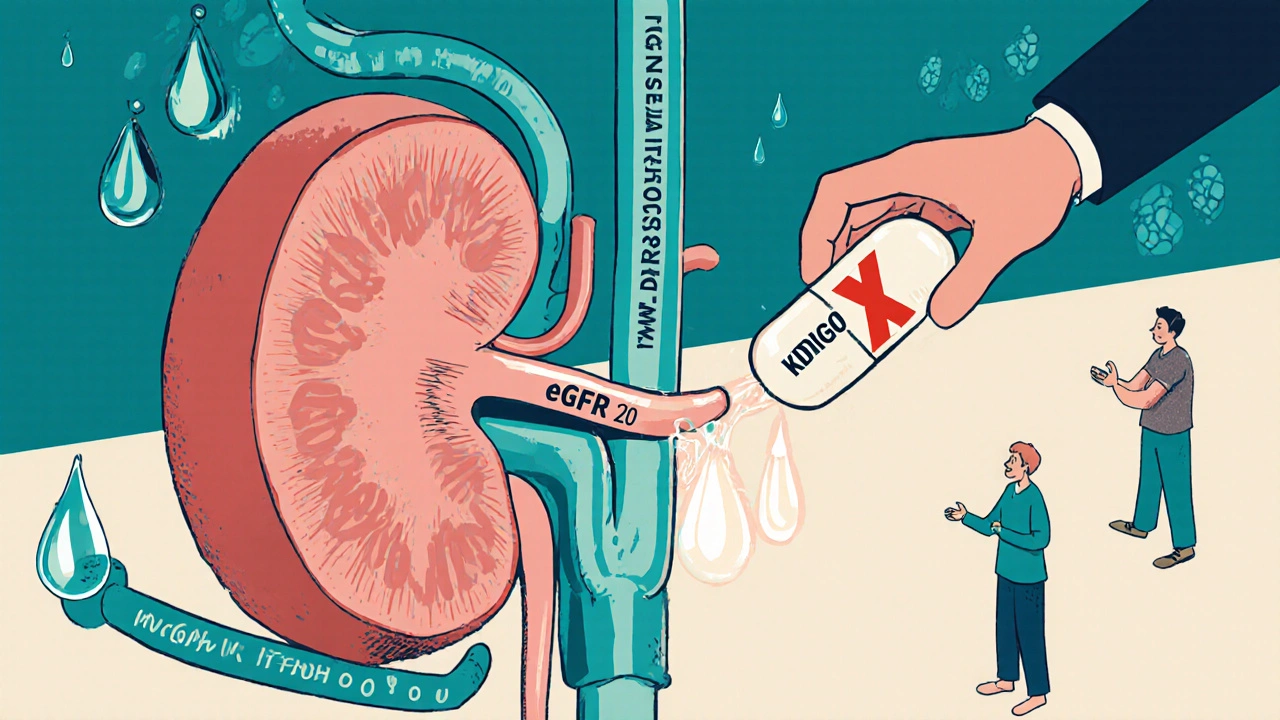
The Tight Window: eGFR 20-29 mL/min/1.73 m²
This is where things get tricky. In this range, you can use SGLT2 inhibitors-but you must stop metformin. That’s because metformin is contraindicated below eGFR 30, but SGLT2 inhibitors are still safe and effective down to 20. So if your eGFR is 25, you switch from metformin to an SGLT2 inhibitor. You don’t take both.
That’s a critical transition point. Many patients are on metformin for years. When their kidneys decline, they’re suddenly told to stop one drug and start another. It’s confusing. It’s scary. But it’s the right move. Studies show that combining metformin with an SGLT2 inhibitor early in kidney disease reduces progression to kidney failure by 30-40%. But once eGFR dips below 30, you lose the metformin benefit and gain no extra protection from keeping it. So switch.
What Happens When You’re on Dialysis?
There’s no clear answer. Metformin is cleared by the kidneys, and dialysis removes it-but not always completely. Some sources suggest 250 mg daily for peritoneal dialysis and 500 mg after hemodialysis. But this is based on small case studies, not large trials. Most guidelines say to avoid metformin entirely in dialysis patients.
SGLT2 inhibitors are not approved for use in dialysis patients. Their mechanism relies on functioning kidney tubules to block glucose reabsorption. If those tubules are gone, the drug doesn’t work. So if you’re on dialysis, SGLT2 inhibitors are off the table. That leaves GLP-1 agonists, insulin, or other non-renal drugs as your main options.
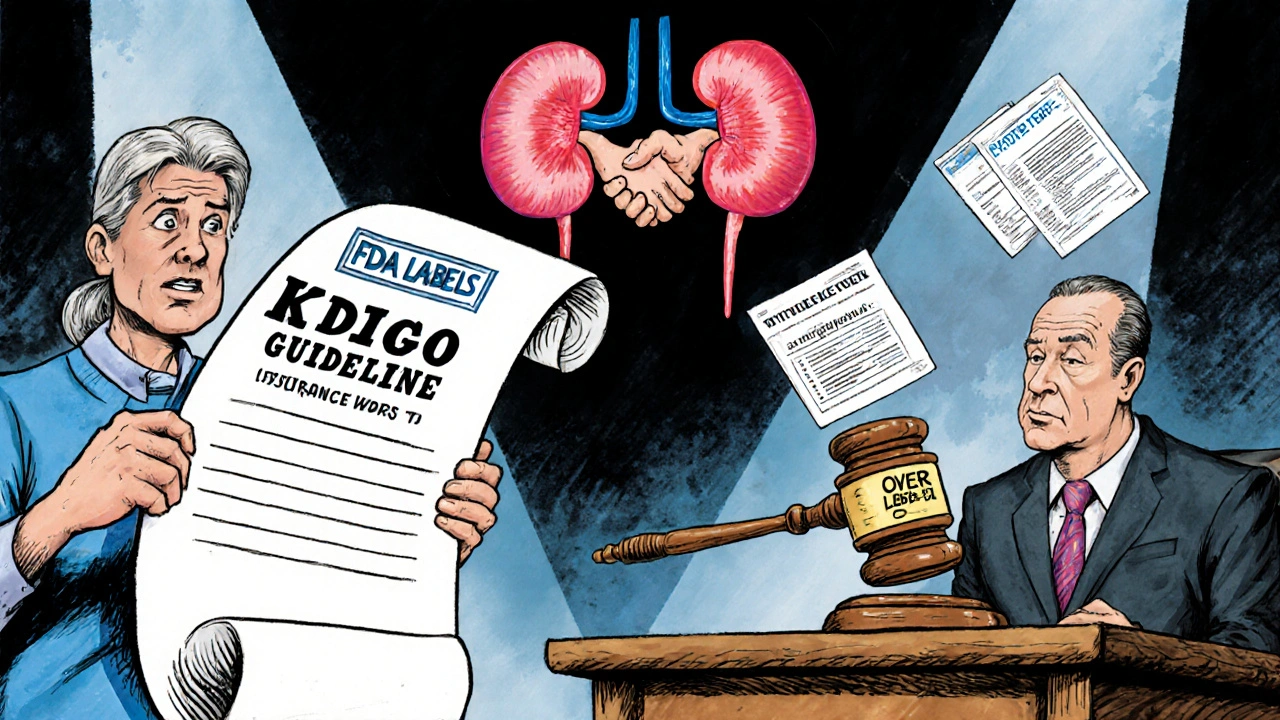
Why Do Insurance Companies Keep Denying These Drugs?
Because they’re still reading the FDA label, not the clinical guidelines. If your eGFR is 22 and your doctor prescribes dapagliflozin, the pharmacy system will flag it as “contraindicated” because the FDA label says eGFR must be ≥25. Even though KDIGO says it’s safe down to 20, and the evidence supports it.
A 2022 survey found 43% of endocrinologists had prescriptions denied for SGLT2 inhibitors in patients with eGFR 20-29. That’s not just frustrating-it’s dangerous. Patients stop their meds. Their kidneys worsen. Their hearts get stressed. You need to fight for these drugs. Ask your doctor to write a letter of medical necessity citing KDIGO 2022 and the DAPA-CKD or EMPA-KIDNEY trials. If they refuse, ask for a peer-to-peer review with the insurer’s medical director.
When to Stop or Hold These Drugs
There are times when you need to pause these medications, even if your eGFR is fine:
- During acute illness (severe infection, vomiting, diarrhea): Hold both metformin and SGLT2 inhibitors for 2-3 days. Risk of dehydration and lactic acidosis goes up.
- Before major surgery: Stop metformin 48 hours before and don’t restart until you’re eating and your kidney function is stable.
- If you’re on strong diuretics (like furosemide): Watch for low blood pressure. SGLT2 inhibitors add to that risk, especially if eGFR is below 30.
- If you have liver disease or heart failure: These drugs are still safe-but monitor closely. Metformin is fine in stable heart failure; SGLT2 inhibitors actually improve outcomes.
What’s Coming Next?
The FDA approved dapagliflozin for kidney disease even without diabetes in February 2024. That’s huge. It means people with CKD who don’t have diabetes can now get kidney protection from this class of drugs. But the label still says eGFR ≥25. KDIGO says ≥20. The gap is still there.
The ADA and KDIGO are working on a 2025 update. Early drafts are looking at whether SGLT2 inhibitors can be used safely in patients with eGFR 15-19 mL/min/1.73 m². Early data from small studies suggest yes-but we need more. Meanwhile, the cost-effectiveness is clear: SGLT2 inhibitors save $128,000 per quality-adjusted life year in patients with eGFR 20-29. That’s not just medical-it’s economic sense.
The future is simple: if you have type 2 diabetes and kidney disease, start an SGLT2 inhibitor as early as eGFR 45. Keep metformin as long as you can. When your eGFR drops below 30, switch to the SGLT2 inhibitor and stop metformin. Don’t stop the SGLT2 inhibitor just because your eGFR dips. And don’t let insurance or outdated labels stop you from getting the best care.
Can I still take metformin if my eGFR is 35?
Yes, you can take metformin at an eGFR of 35, but your daily dose must be limited to 1000 mg. At this level, your kidneys are moderately impaired, so reducing the dose lowers the risk of lactic acidosis, which is already extremely rare. Check your eGFR every 3 months and avoid metformin during illness or dehydration.
Why is my eGFR lower after starting dapagliflozin?
It’s normal. SGLT2 inhibitors like dapagliflozin reduce pressure inside the kidney’s filtering units, which causes a temporary drop in eGFR-usually 2 to 5 mL/min/1.73 m². This isn’t damage. It’s the drug working to protect your kidneys long-term. Wait 8-12 weeks. If your eGFR stabilizes or improves, keep taking it. If it keeps falling, talk to your doctor about other causes.
Can I take both metformin and an SGLT2 inhibitor together?
Yes, if your eGFR is 30 or higher. In fact, combining them early in kidney disease reduces the risk of kidney failure by 30-40%. But if your eGFR drops below 30, stop metformin and keep the SGLT2 inhibitor. Don’t take both below eGFR 30-metformin becomes unsafe, and you don’t gain extra benefit from keeping it.
Is empagliflozin safe if my eGFR is 28?
Yes. Empagliflozin is approved for use down to eGFR 30, and KDIGO guidelines support continuing it even below that if you’re stable. At eGFR 28, you’re within the recommended range. Keep the dose at 10 mg daily. Monitor for signs of low blood pressure or dehydration, especially if you’re also on diuretics. Don’t stop it just because your eGFR dropped from 32 to 28-that’s expected.
What if my insurance denies my SGLT2 inhibitor because my eGFR is 22?
Ask your doctor to write a letter of medical necessity citing the KDIGO 2022 Clinical Practice Guideline and the DAPA-CKD or EMPA-KIDNEY trials. Insurance companies often rely on outdated FDA labels. The evidence shows SGLT2 inhibitors are safe and effective down to eGFR 20. If they still deny it, request a peer-to-peer review with their medical director. This is a known issue-43% of endocrinologists report similar denials. You’re not alone, and you’re not wrong.

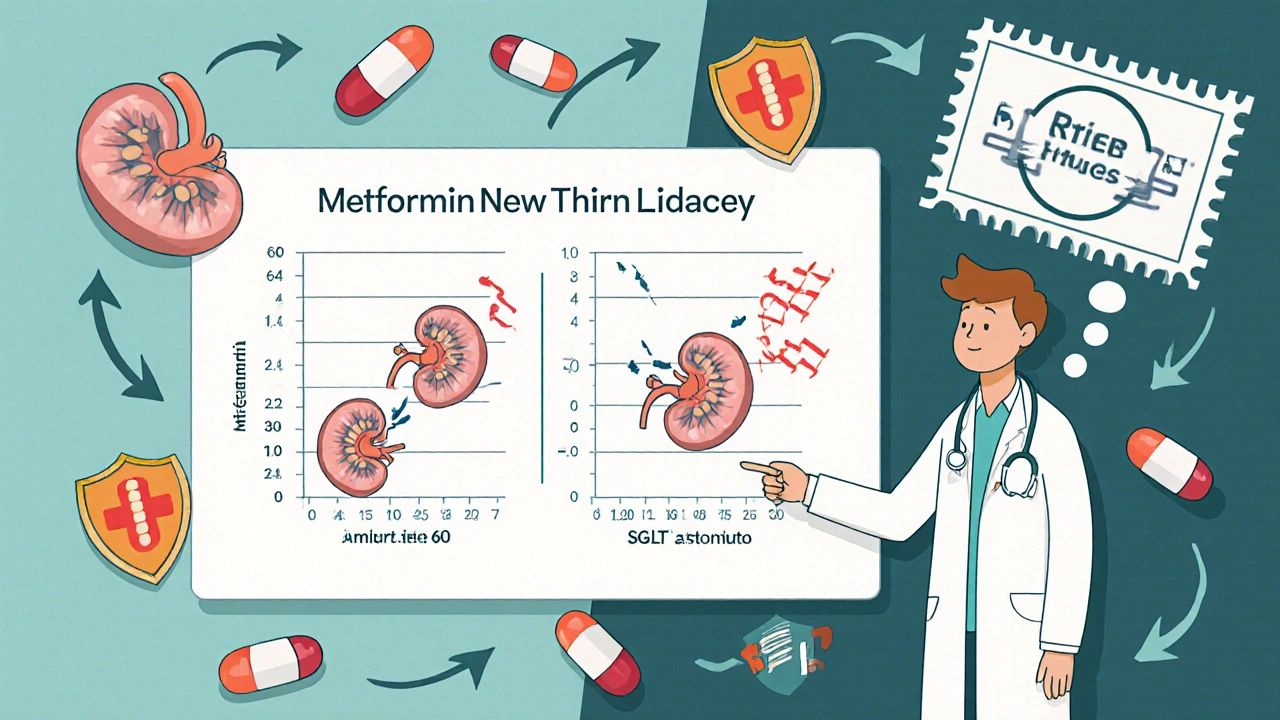
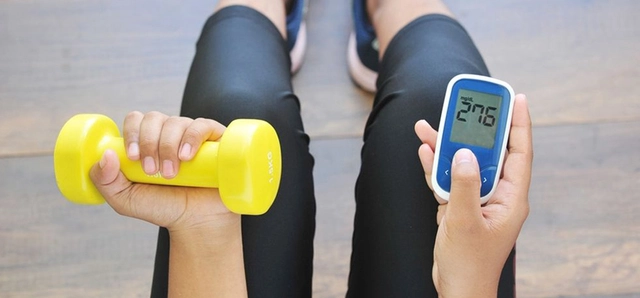
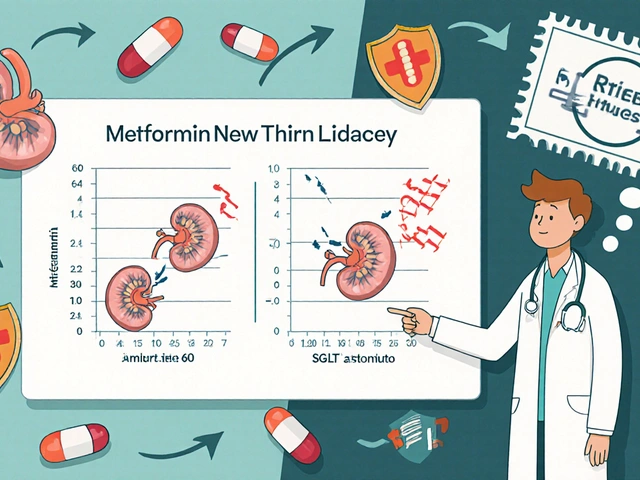
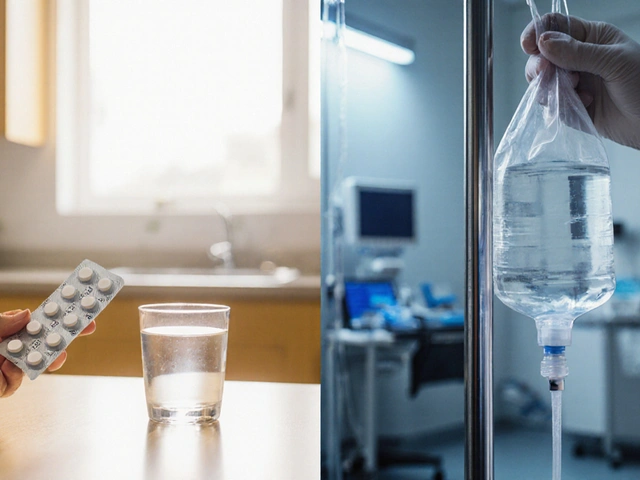
Liam Strachan
Finally, someone laid this out clearly. I’ve seen too many patients get pulled off metformin just because their eGFR dipped to 55. No real benefit, just unnecessary risk. The data’s been clear for years.
Russ Bergeman
Wait-so you’re saying insurance companies are still denying metformin based on outdated guidelines? That’s not just bureaucratic laziness-that’s malpractice by proxy.
Katie Magnus
Everyone’s acting like this is some big revelation. I’ve been telling my endo this for years. He just shrugged and said, ‘That’s not what the rep told me.’
Michael Fessler
Metformin’s renal safety profile is one of the most robust in endocrinology. Lactic acidosis risk is negligible below eGFR 30 if you avoid acute decompensation. SGLT2i’s cardiorenal benefits are even more compelling-EMPA-REG, CREDENCE, DAPA-CKD all show hard endpoint improvements. Dosing adjustments are straightforward: stop if eGFR <20 for SGLT2i, but keep metformin at 1000mg if stable at 30–44.
daniel lopez
They say it’s ‘safe’ but who funded those studies? Big Pharma. The FDA changed the label because they wanted to sell more drugs. You think metformin’s cheap? Wait till you see the price of SGLT2 inhibitors after the patent cliff. This is all a money play.
Nosipho Mbambo
Why do we keep pretending kidney function is just a number? I’ve seen patients with eGFR 42 who are healthier than people with eGFR 70 who smoke, drink, and sit all day. You can’t just rely on labs-clinical context matters. Also, why is nobody talking about diet?
Ravinder Singh
Great breakdown. I’ve been using this algorithm in my clinic in India for the last 3 years. Patients love it-cheaper meds, fewer side effects, better adherence. The real barrier isn’t science-it’s access. In rural areas, even basic eGFR tests are hard to get. We need policy changes, not just guidelines.
King Over
Metformin still works fine at 35 eGFR if you monitor. No need to panic. SGLT2i are great but not magic. Just don’t stop the metformin.
Johannah Lavin
This is the kind of info that saves lives. Thank you for sharing it. I’ve had patients cry because they were told to stop metformin and thought they’d lose control forever. They didn’t know it was safe. We need to spread this like wildfire.
Ron and Gill Day
Wow. Another one of those ‘I read a study’ posts. Did you actually treat a single patient with CKD or just skim a KDIGO abstract? Real clinicians know you don’t just blindly follow guidelines-you assess risk, comorbidities, and patient goals. This oversimplification is dangerous.
Gerald Cheruiyot
It’s not about blindly following guidelines. It’s about updating them when evidence shifts. The old 60 cutoff was based on case reports from the 80s. The new data? 100+ studies. That’s not opinion. That’s science. And if you’re still using 1980s logic in 2025, you’re doing patients a disservice.
Dana Oralkhan
Thank you for this. I’m a nurse practitioner and I’ve had to fight insurance denials for months just to keep patients on metformin. One woman said she’d rather go without insulin than lose her metformin. It’s her anchor. I’m glad the science is finally catching up to what we see every day.